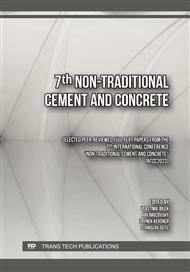p.55
p.69
p.77
p.87
p.97
p.107
p.119
p.131
p.141
Cement-Based Coating as Concrete Anti-Carbonation Barrier
Abstract:
During the research study focused on 100-year-old concrete bridges, a couple of them were found with a very low carbonation depth under an ordinary cement-based protective render coat (PRC). Phenolphthalein test showed at this place carbonation depth up to 2 mm. Bridge concrete was carbonated up to 80 mm, when a PRC spalled up. Close correlation between the surface permeability of a PRC estimated by the Torrent method and the carbonation depth of the base concrete beneath it, was observed. Most of the PRCs appeared to be almost impermeable showing the coefficient of permeability below 0.01 × 10-16 m2. The field experiments were replaced by those of laboratory-made aiming to a PRC development from currently available materials. For this purpose, material composition and rheological optimization of the PRCs were suggested and relevant tests performed. The PRCs applied to a surface of concrete panel were tested for permeability (Torrent method), adhesion (target) and crack propagation. The resistance to carbonation of the plain concrete C8/10 strength class according to EN 206 + A2 and those of PRC-protected were verified by an accelerated carbonation in 20 °C/60 % R.H./20 % vol. CO2-exposure. By contrast, dry-air cure served as a reference cure. This article is mainly focused on the laboratory tests evaluation and explanation of the observed low carbonation of the base concrete covered by a PRC.
Info:
Periodical:
Pages:
119-130
Citation:
Online since:
March 2024
Authors:
Keywords:
Price:
Сopyright:
© 2024 Trans Tech Publications Ltd. All Rights Reserved
Share:
Citation:


